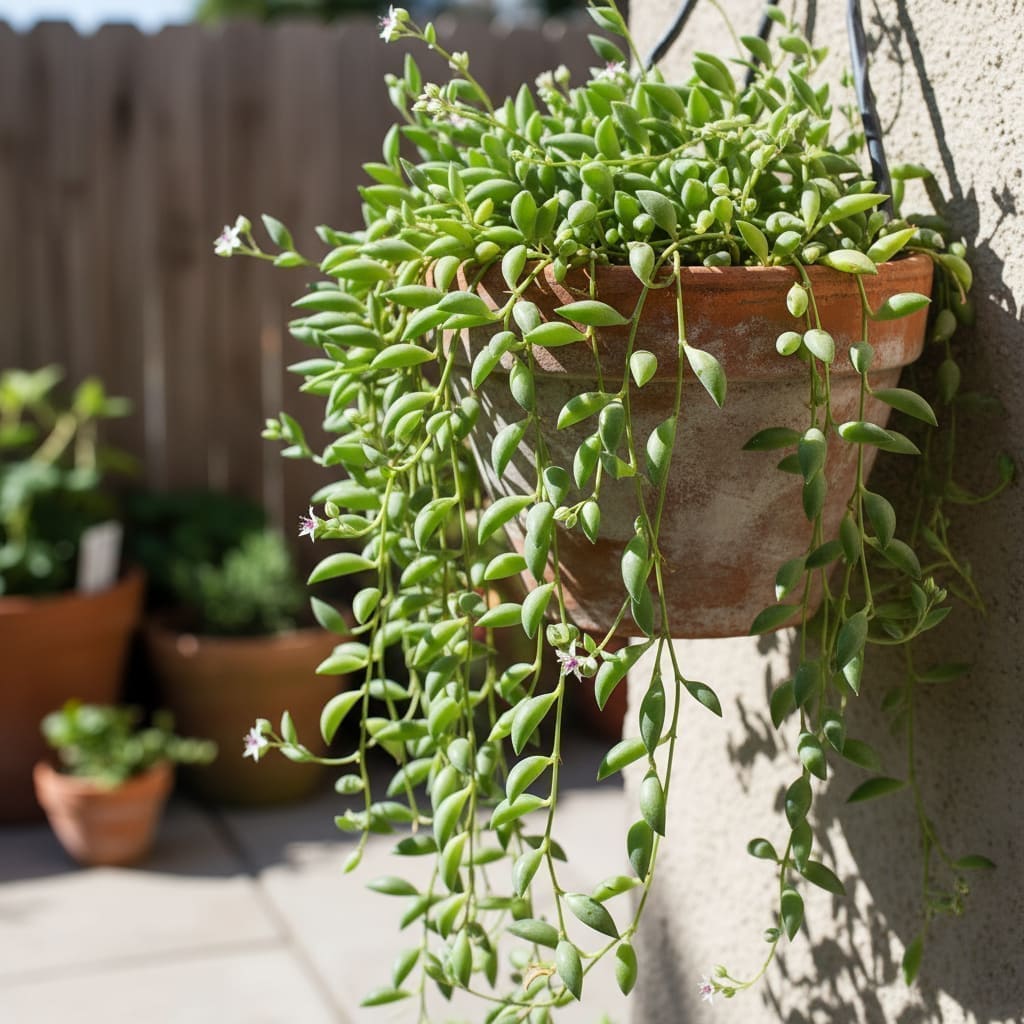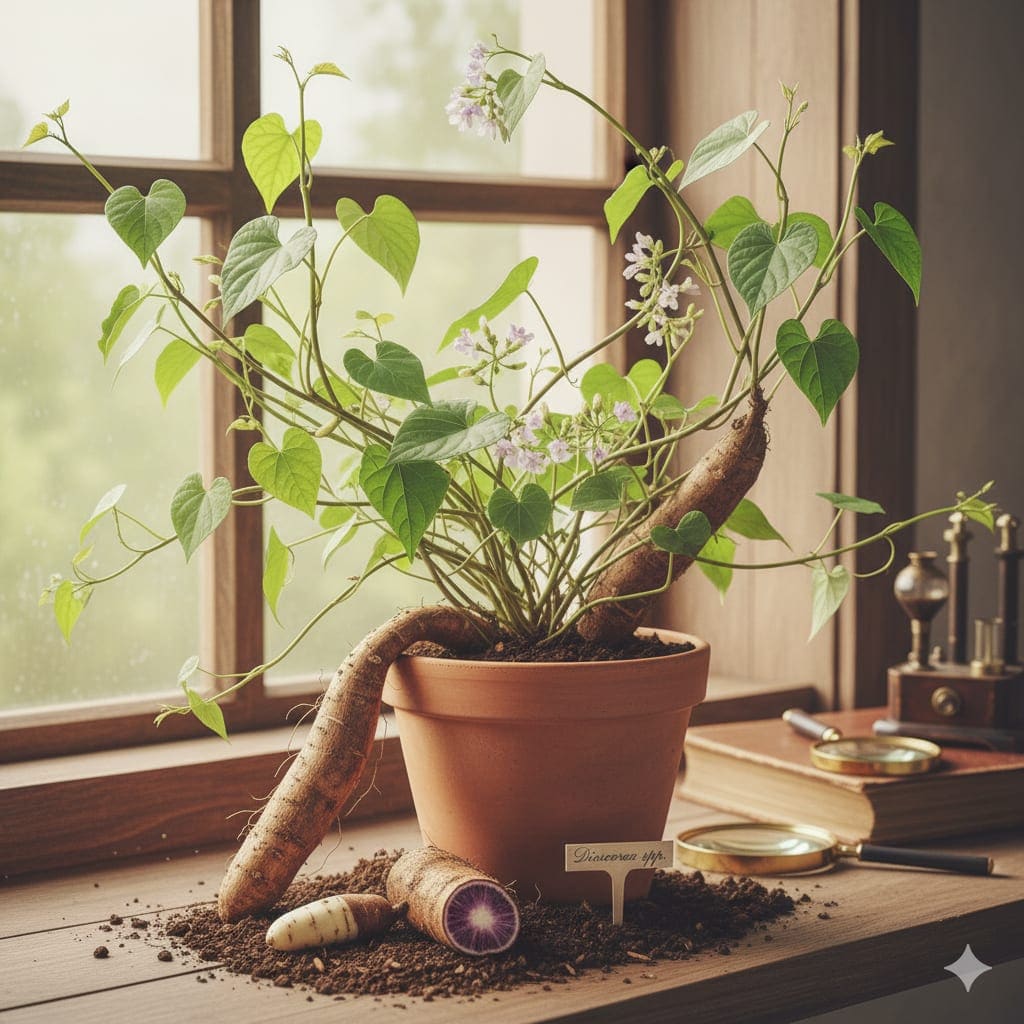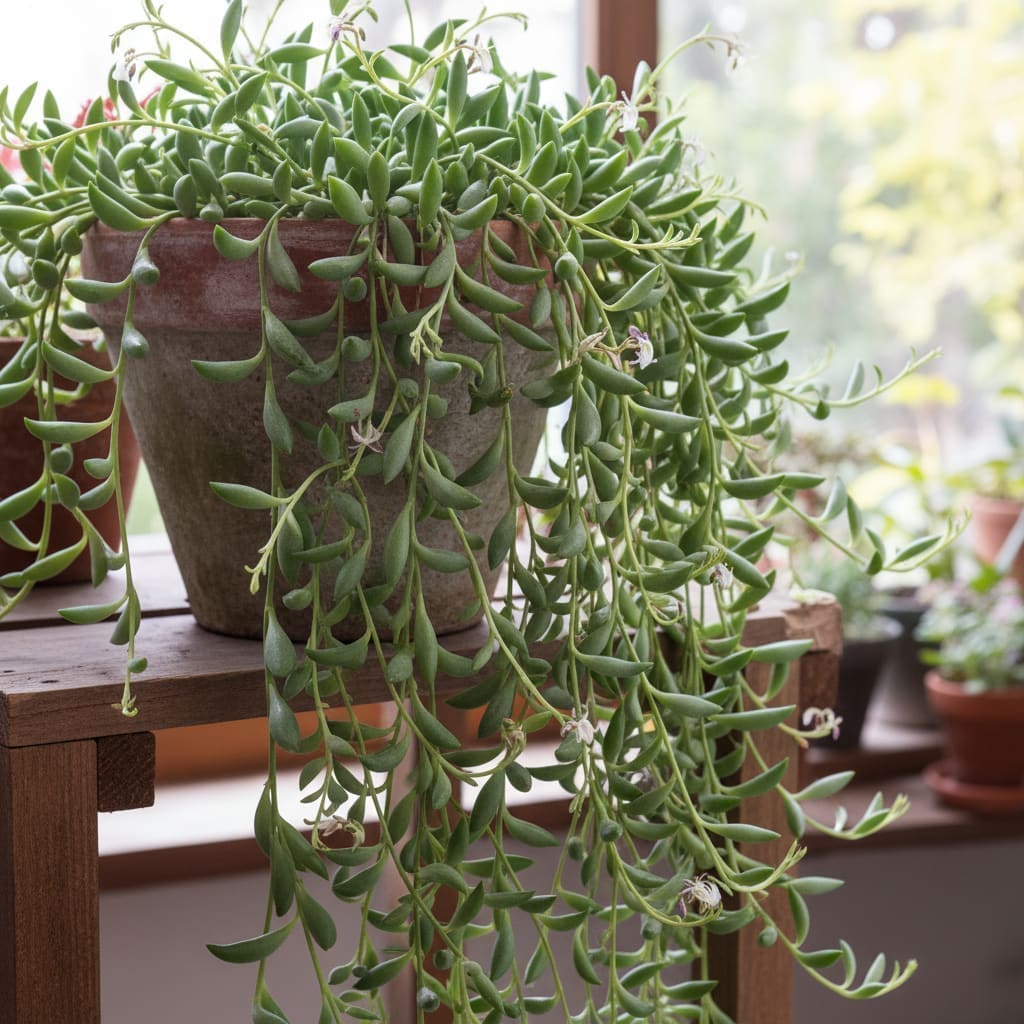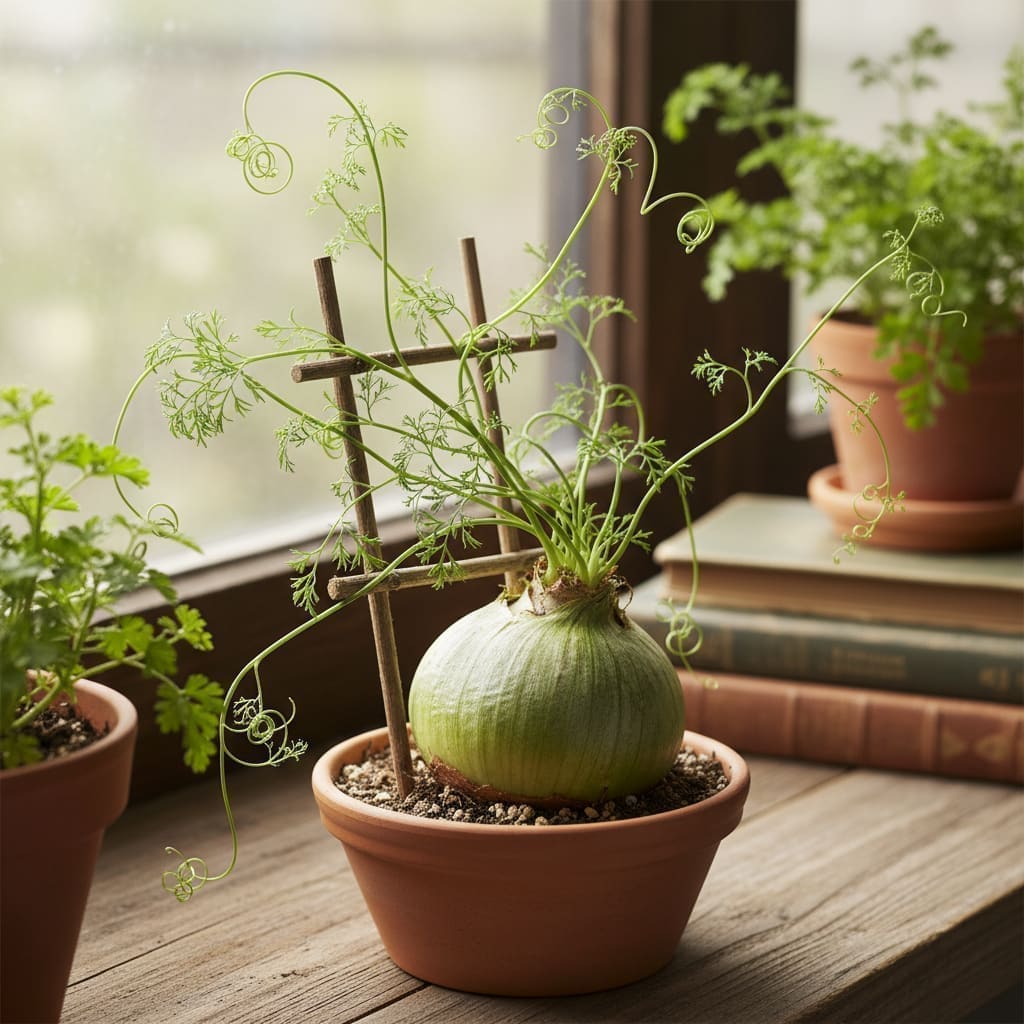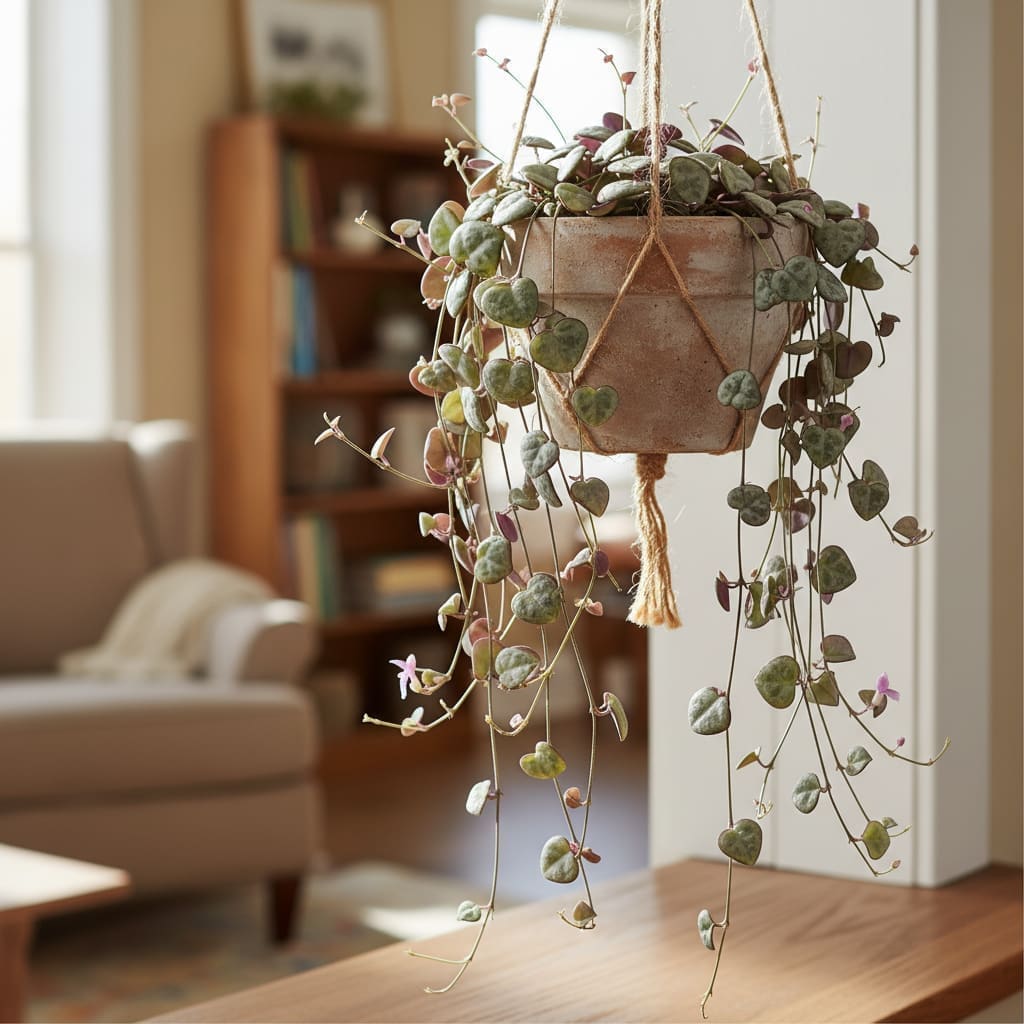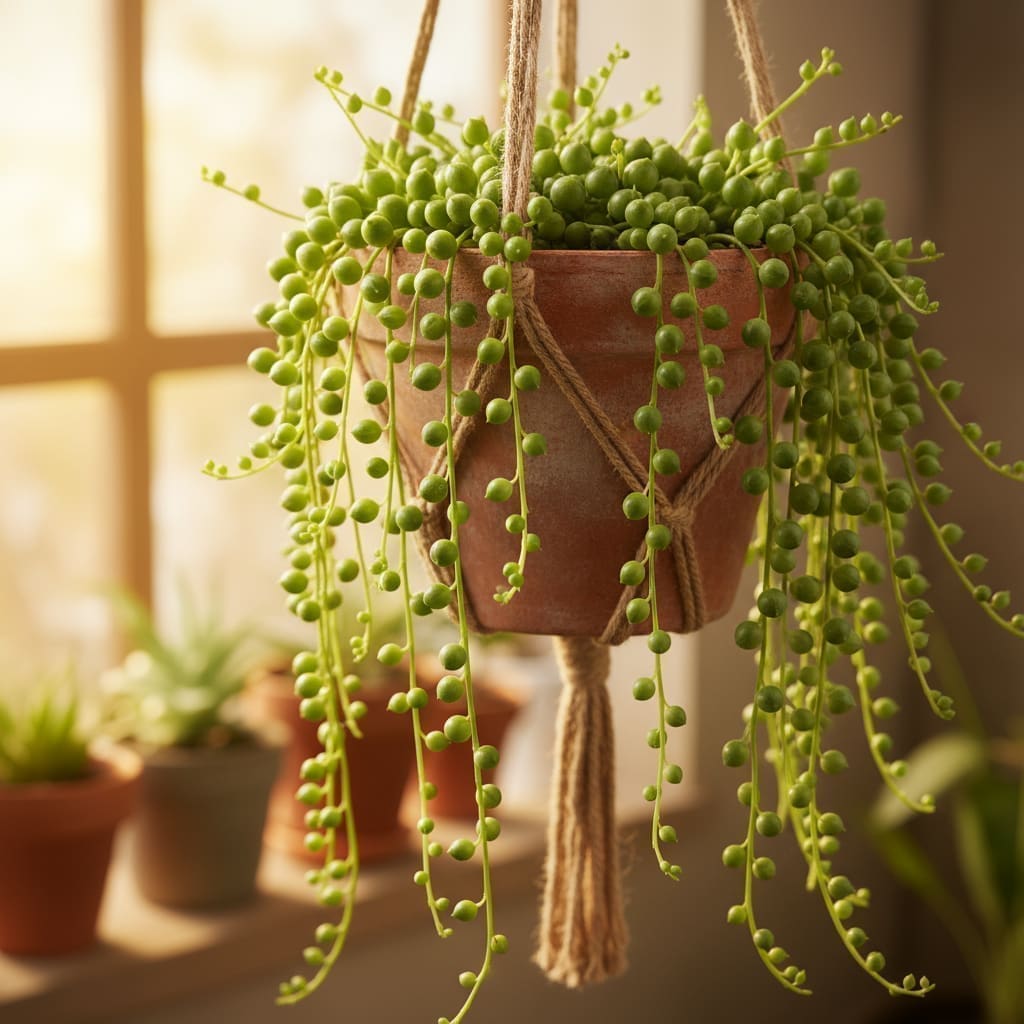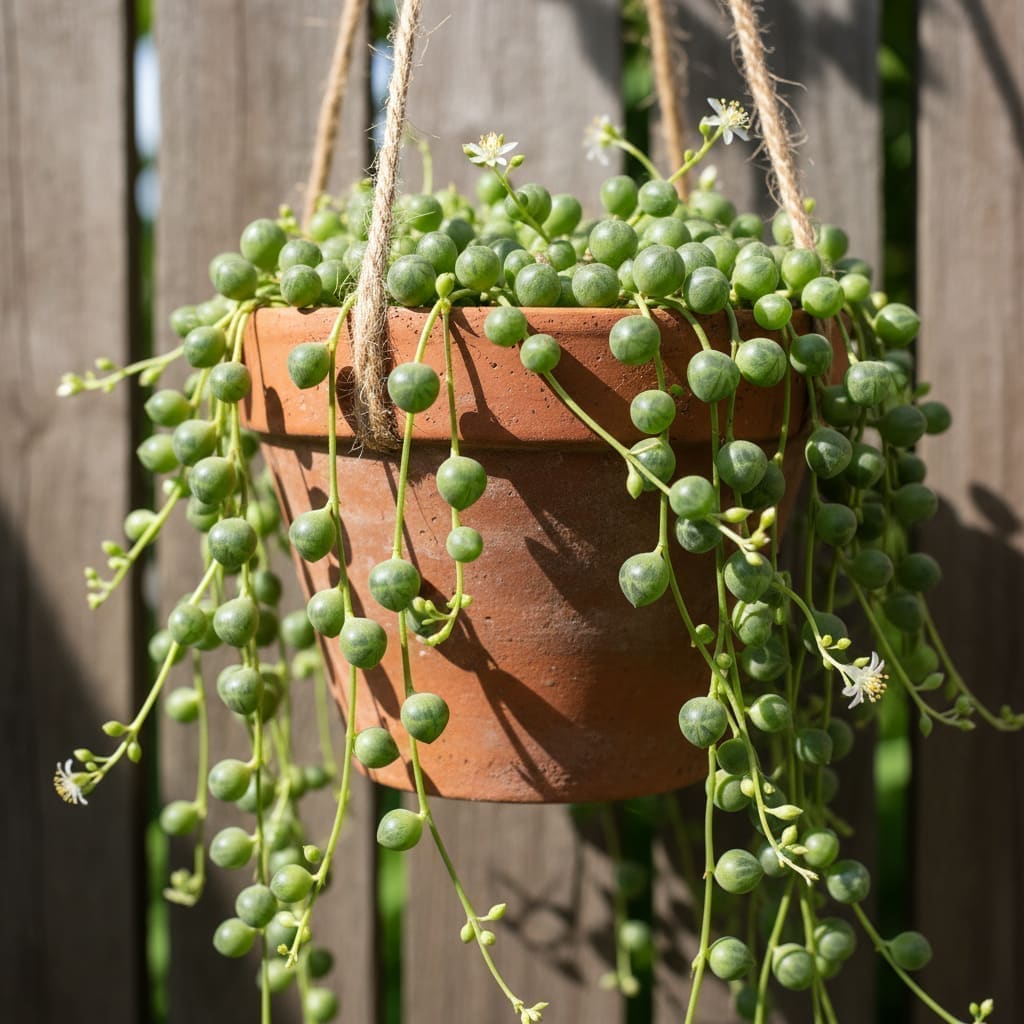String of Dolphins (Curio × peregrinus) Care Guide
Overview
Curio × peregrinus, commonly known as the String of Dolphins, is a rare and charming succulent hybrid native to South Africa. It is prized for its cascading vines adorned with leaves shaped like tiny leaping dolphins. This plant is a cross between Curio rowleyanus (String of Pearls) and Curio articulatus (Candle Plant), inheriting the trailing habit of its parents and the whimsical leaf form that makes it a standout in any succulent collection.
As a low-water, bright-indirect light succulent, the String of Dolphins is well-suited for indoor hanging baskets, shelves, or as part of a mixed succulent display. Its unique foliage and relatively easy care make it a favorite among collectors and casual plant owners alike.
Identification & Growth Habit
The String of Dolphins produces slender, trailing stems that can reach lengths of 1–3 feet (30–90 cm) over time. Along these stems grow fleshy, curved leaves with a central notch, giving the appearance of dolphins mid-leap. The plant’s growth is primarily trailing, but it can be gently trained to climb if given support such as a trellis or moss pole.
In optimal conditions, mature plants may produce small, white to pale pink, cinnamon-scented flowers in late fall or early winter, although flowering indoors is uncommon.
Light & Placement
- Light: Bright, indirect light is ideal. A south- or west-facing window with filtered light works well.
- Adaptability: Can tolerate medium light but will grow more slowly and may lose its compact form.
- Avoid: Prolonged direct sun, especially in summer, as it can scorch the leaves.
Rotate the plant occasionally to encourage even growth and prevent leaning toward the light source.
Watering & Humidity
As a succulent, the String of Dolphins stores water in its leaves and stems. Allow the soil to dry out completely between waterings. Water thoroughly, letting excess drain away. Reduce watering in fall and winter when the plant enters a semi-dormant phase.
- Humidity: Average household humidity (40–50%) is sufficient.
- Air circulation: Good airflow helps prevent fungal issues and rot.
Soil & Repotting
Use a well-draining succulent or cactus mix. To improve drainage, amend with coarse sand, pumice, or perlite. Avoid heavy, moisture-retentive soils.
- Repotting: Every 2–3 years or when the plant becomes root-bound. Choose a pot with drainage holes.
- Container material: Terracotta pots help wick away excess moisture.
Fertilizing
Feed sparingly during the active growing season (spring and summer) with a diluted, balanced liquid fertilizer (e.g., 10-10-10) at half strength once a month. Avoid over-fertilizing, as excessive nutrients can cause elongated growth and leaf distortion.
Pruning & Training
Prune to maintain shape, encourage branching, and remove any shriveled or damaged stems. Use clean, sharp scissors or pruning shears.
- Trailing display: Allow stems to cascade from hanging baskets or high shelves.
- Climbing/training: Gently guide stems onto a small trellis or moss pole for a vertical display.
Propagation (Step-by-Step)
- Select a healthy stem with several leaves.
- Cut a 3–5 inch (7–12 cm) section using clean scissors.
- Remove leaves from the bottom 1–2 inches of the cutting.
- Allow the cut end to callous over for 1–2 days in a dry, shaded spot.
- Plant the calloused end in well-draining succulent soil.
- Place in bright, indirect light and water lightly after a few days.
- Resume normal watering once roots are established (2–4 weeks).
Common Problems
Pests
- Mealybugs: Appear as white, cottony masses. Treat with insecticidal soap or neem oil.
- Aphids: Small green or black insects on new growth. Rinse off or use insecticidal spray.
- Spider mites: Fine webbing and stippling on leaves. Increase humidity slightly and treat with miticide.
Diseases
- Root rot: Caused by overwatering or poor drainage. Remove affected roots and repot in fresh, dry soil.
- Fungal spots: Brown or black spots may indicate fungal infection; improve airflow and remove affected leaves.
Toxicity & Pet Safety
The String of Dolphins is considered toxic if ingested by humans, cats, or dogs. Keep out of reach of pets and children, and handle with care when pruning or repotting.
Styling & Decor Tips
- Display in hanging planters to showcase the cascading vines.
- Use as a whimsical accent in a succulent arrangement.
- Pair with contrasting foliage plants for visual interest.
- Place near eye level to appreciate the dolphin-shaped leaves.
Varieties & Cultivars
As a specific hybrid, Curio × peregrinus does not have many named cultivars. However, leaf size and dolphin shape can vary slightly between specimens due to growing conditions and genetic variation.
Buying Tips & Maturity
- Look for firm, plump leaves with clear dolphin shapes.
- Avoid plants with mushy stems or signs of pests.
- Young plants may have shorter vines; with time and proper care, they will develop long, full cascades.
Seasonal Care
- Spring/Summer: Active growth; regular watering after soil dries, monthly feeding, bright light.
- Fall/Winter: Reduce watering, no fertilizer, maintain bright light and temperatures above 40°F (4°C).
FAQ
- How much light does a String of Dolphins need? Bright, indirect light is best. It can adapt to medium light but may grow slower.
- Why are my dolphin leaves shrinking? Likely due to underwatering or prolonged drought; check soil moisture and adjust watering.
- Can String of Dolphins grow outdoors? Yes, in frost-free climates with bright, indirect light or light shade.
- How often should I fertilize? Once a month during spring and summer with a diluted, balanced fertilizer.
- Is it safe for pets? No, it is toxic if ingested by cats, dogs, or humans.
Troubleshooting Scenarios
- Leggy growth with widely spaced leaves: Indicates insufficient light; move to a brighter location or supplement with a grow light.
- Wrinkled leaves despite moist soil: Roots may be damaged from rot; inspect root health and repot into fresh, dry mix if necessary.
- Leaves turning translucent: Sign of overwatering; allow soil to dry thoroughly before resuming a reduced watering schedule.
- No new growth in spring: Check for compacted soil or root binding; repot and refresh soil to encourage vigor.
Advanced Pruning & Training Techniques
For fuller baskets, pinch back vine tips during the active season to stimulate side branching. To create a living wreath or topiary, wrap flexible stems around a wire frame, securing gently with soft plant ties. Periodically rotate the structure to maintain even coverage and prevent one-sided growth.
Companion Plant Suggestions
- String of Pearls (Curio rowleyanus): Complements dolphin shapes with spherical beads.
- Burro’s Tail (Sedum morganianum): Contrasts with thicker, overlapping leaves.
- Trailing Jade (Senecio jacobsenii): Adds warm tones in cooler months.
- Air Plants (Tillandsia spp.): Provide textural contrast without competing for soil space.
Seasonal Care Calendar
| Season | Tasks |
|---|---|
| Early Spring | Repot if needed, prune for shape, resume feeding. |
| Late Spring–Summer | Maintain bright light, water after soil dries, pinch tips for fullness. |
| Autumn | Reduce watering, stop fertilizing, inspect for pests before bringing indoors (if outside). |
| Winter | Keep in bright light, water sparingly, avoid cold drafts. |
Do & Don’t List
- Do: Use breathable pots, provide bright indirect light, and rotate regularly.
- Do: Allow cuttings to callous before planting to prevent rot.
- Don’t: Let the plant sit in water or overly humid, stagnant air.
- Don’t: Place in low light for extended periods if you want to maintain compact dolphin shapes.
